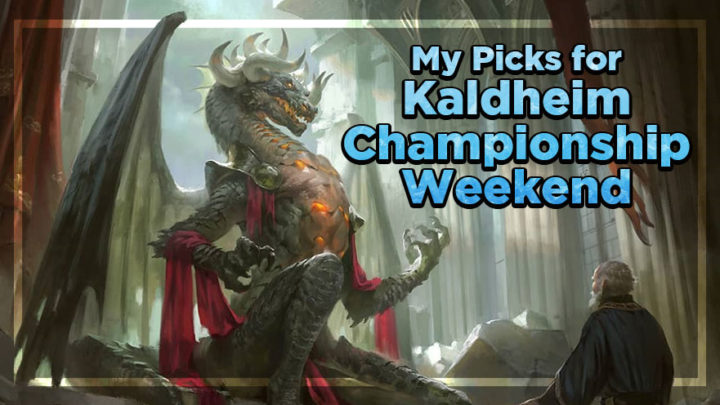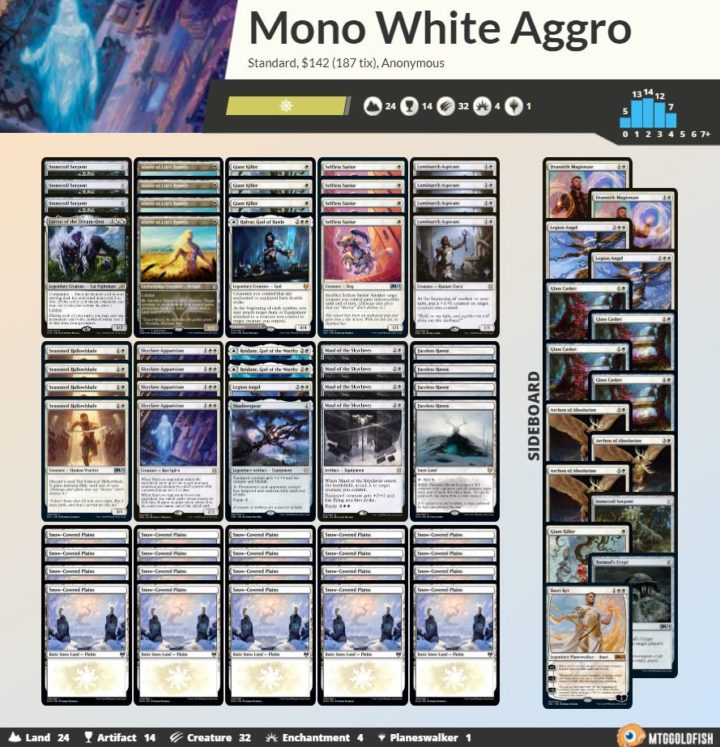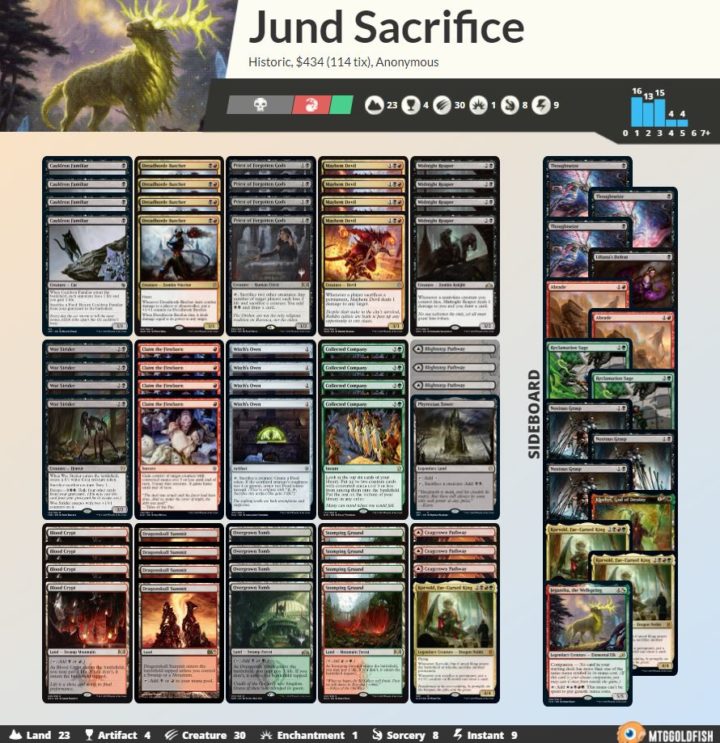This upcoming weekend, I’ll be competing in the Kaldheim Championship. Like previous Championships, Player’s Tours and the like, it’s a split format event, showcasing Standard and Historic. Day One consists of three rounds of Standard and four rounds of Historic, with four or more match wins necessary to advance to Day Two.
Because of the extra emphasis on Historic for Day One, my testing team and I spent the most time focusing on Historic, and I’m confident in the deck I chose for that format. I’ve been tuned out of Standard for a couple of weeks, but we were able to catch up and solidify an archetype I was comfortable registering for this event.
Standard
The Standard metagame has been cycling quickly through a handful of “best decks,” and it can be difficult to figure out what to register for a tournament. Oftentimes, the best deck in any given week ends up getting crushed the next week. Unfortunately, during my last Rivals League Weekend, I ended up falling prey to the constant metagame churn. I registered Mono-Red Aggro because I wanted to play the deck that was winning the most at the time, but my opponents metagamed hard against the deck.
As the Kaldheim Championship approached, I tried to focus on which decks I would be facing the most instead of just resolving to play the “best deck.” Instead of guessing what a handful of my peers were playing, I had to analyze the broader metagame.
As of last week, the three most played decks in Standard were Sultai Ultimatum, Mono-Red Aggro, and Temur Adventures. Cycling was the archetype to beat the previous week, and Mono-Red Aggro was the top deck the week before that. Both of these decks did poorly when they were the deck to beat because they had the largest targets on their backs, so I decided not to register either of them. Instead, I went with Mono-White Aggro.
When looking at a couple of data sets, I saw that Mono-White had a positive matchup against two out of three of the most popular decks. It’s also the only deck that has a positive matchup against both Sultai and Mono Red. While the Temur Adventures matchup isn’t necessarily positive for Mono-White, it’s close enough that I was content with my deck selection overall. Plus, besides the top three Standard decks, Mono-White Aggro also has positive matchups against Cycling, Dimir Rogues, and Gruul Adventures.
If all these matchups are positive, then it may seem like Mono-White Aggro is the obvious choice. But it’s also worth noting that the deck has fallen off the radar in recent weeks and considering the reasons why. As Standard progresses, aggressive strategies tend to fall off as players find effective ways to combat them. Sultai Ultimatum, the most popular control deck in the format, has adjusted its numbers to account for the uptick in aggro decks, including adding additional exiling board wipes and creatures like Elder Gargaroth and Polukranos.
However, Mono-White Aggro is typically favored against Sultai Ultimatum is because it’s in the best position to capitalize when the Sultai stumbles. If Sultai misses a land drop or doesn’t have early interaction, Mono-White can overwhelm them with resilient creatures or shut off their board wipes and win conditions with cards like Reidane.
From week to week, Mono-White’s matchup win percentages change because of how the rest of the decks in the format are built. This upcoming week felt like a great time to register Mono-White because it’s off people’s radar, and it has positive matchups against the decks I expect to see the most of.
Historic
It’s been clear for a long time that Jund Sacrifice is the most powerful thing you can be doing in Historic right now. You get Mayhem Devil, Claim the Firstborn, Collected Company, Korvold, Fae-Cursed King — there aren’t any other decks in Historic with this many powerful cards that fit perfectly together. My testing team and I started with the assumption that we had to play a Sacrifice deck or a deck that beat Sacrifice, and that assumption was confirmed as Sacrifice decks dominated events last weekend.
Regardless of where I landed, it was clear that Jund Sacrifice was going to be the most popular deck in Historic. That naturally ruled out a lot of decks with unfavorable Jund Sacrifice matchups: Rakdos Arcanist, Orzhov Auras, and Rakdos Sacrifice. While Rakdos Sacrifice is extremely powerful, and often better across the Historic field than Jund Sacrifice, Rakdos struggles significantly in the head-to-head. If Jund Sacrifice would have the largest metagame share, registering Rakdos Sacrifice wouldn’t give us much of an edge against the field.
From there, I narrowed down my options to Jund Sacrifice, Azorius Control, and Angels. My goal was to see if any deck could consistently beat Jund Sacrifice enough to make a meta call worth it. Azorius Control and Bant Control (which was splashing green for Yasharn) failed the test, as I more or less expected they would. I initially thought Angels would be a bad matchup for Jund Sacrifice — they go wide, have mostly flyers, and gain bundles of life at a time — but after testing, Jund Sacrifice appeared to be slightly favored. This locked in the choice for me.
Of course, I still had to settle on a build of Jund Sacrifice to register. There are currently two different Jund decks dominating Historic: Jund Sacrifice and Jund Food. What’s the difference, and which version is better?
Both versions are similar, relying heavily on the synergies between Cauldron Familiar, Witch’s Oven, and Mayhem Devil. However, Jund Food is a slower deck with more interaction and card advantage; it plays cards like Trail of Crumbs, Binding the Old Gods, and Korvold. On the Jund Sacrifice side, these spots are dedicated to more proactive and aggressive cards like Dreadhorde Butcher, Collected Company, and Priest of Forgotten Gods.
As far as matchups go, we have a little bit of data from last weekend’s SCG events that we can draw from. A lot of the win rates between the two versions are similar, with Jund Food being slightly better against Azorius Control and in the head-to-head. On the flip side, Jund Sacrifice is better against Gruul Aggro, Sultai Ultimatum, and Goblins. Based on that data alone, I would likely opt to register Jund Food, but it’s worth keeping in mind that last weekend’s Jund Sacrifice decks may not have been tuned for the mirror or for Jund Food.
That said, many Jund Sacrifice sideboards have adapted drastically over the past week to better fight the developing metagame. They’ve started running Liliana’s Defeat as a one-mana removal spell for opposing Korvolds, Klothys, God of Destiny to whittle down life totals and empty the graveyard, and Korvold to push across the finish line or refuel your hand. My current sideboard is geared to beat the mirror, UWx decks, and creature decks — which is exactly where you want to be in Historic right now.
The biggest reason to play Jund Sacrifice in my eyes is Priest of Forgotten Gods. Priest is frequently the best card in the deck, and that’s before you account for its ability to kill multiple creatures with a Mayhem Devil and a Dreadhorde Butcher. While both versions of Jund will be heavily represented at the Kaldheim Championship, aggressive creature decks like Gruul Aggro and Orzhov Auras will be popular, too, and I wouldn’t want to face them without Priest. Additionally, Priest is great in the mirror, pairs well with Claim the Firstborn, helps cast bigger spells like Collected Company and Korvold, and lets you play Noxious Grasp at instant speed on your opponent’s turn when they think you’re tapped out.
***
While I always wish I had more time to prepare for an important event, I’m very happy at where I landed for the Kaldheim Championship. Until then, I’m going to continue testing Standard and finalizing my sideboarding plans in Historic, and you can join me on Twitch!

Ally Warfield is a member of the Rivals League, a full-time streamer, and a Splinter Twin apologist. Her focus is in Historic and Standard, but she also loves to dabble in Vintage and Limited formats as well.



